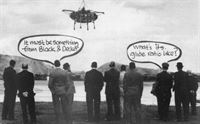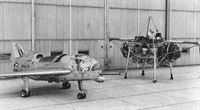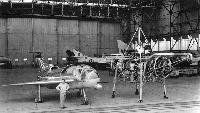
Фотографии
-
Air International 1993-11 / J.Fricker - Mirage might have beens
Регистрационный номер: XJ314 [7] 3 августа 1954г.: экспериментальный ЛА с двумя двигателями "Нин", предназначенный для отработки силовой установки для СВВП Harrier, летающий стенд Rolls-Royce Thrust-Measuring Rig выполнил первый "свободный" полет, без привязи.
Initial trials of engines having sufficiently high thrust to weight ratios to enable vertical take-off were carried out with the Rolls-Royce Flying Bedstead, serialled XJ314. Its first untethered flight took place in 1954. -
Aviation Historian 7 / C.Pocock - The Dragon Lady goes to sea
Регистрационный номер: XJ314 [7] One of the British pilots assigned to Detachment G, Sqn Ldr Ivor Webster, had plenty of experience with unusual and awkward aircraft, including Rolls-Royce’s ‘‘Flying Bedstead”, which made its first hops in July 1953.
-
Aeroplane Monthly 1985-04 / R.Harvey - Flying the bedstead (2)
Регистрационный номер: XK426 The second Bedstead, XK426, distinguishable from the first by the serials stencilled on the oleos and the cowlings over the pitch nozzles.
-
OS 1 / H.Cowin - X-Planes
British had been flying the visually attention-grabbing Deflected Thrust' Gloster Meteor flight test bed for some years, but even with this priming, there were few ready to accept Rolls-Royce's Thrust Measuring Rig, or TMR, as anything less than an aeronautical aberration. How wrong they were was soon to be proved, for while never coming close to such 'tail sitters' as the XFV-1 and XFY-1, or Ryan X-13 in relation to aircraft structural norms, the curious TMR, with its two 5,000lb s.t. Rolls-Royce Nenes mounted back-to-back and its puffer jet stabilisation led directly to Europe's first 'flat riser', Short's SC.I, while the 'tail sitters' led nowhere. Dubbed the 'Flying Bedstead' by the press, the TMR made its first untethered flight on 3 August 1954, in the capable hands of Capt. R.T. Shepperd and marginally under a year after its first tethered outing, two TMRs were built and allocated serial nos XJ 314 and XK 426. The fact that testing these cumbersome devices, capable of little more than 34mph horizontally, or going above 50 feet, was still dangerous was to be horribly illustrated when the second TMR struck the gantry to which it was tethered and crashed, killing its RAF pilot, Wg. Cdr. H. G. F. Larson.
-
Aeroplane Monthly 1985-03 / R.Harvey - Flying the bedstead (1)
Регистрационный номер: XJ314 [7] The picture shows Capt R. T. Shepherd hovering high over Hucknall in the first Bedstead, XJ314, sometime before January 1955. It had made its first free flight, with Shepherd at the controls, on August 3, 1954, after tethered flights during the preceding 12 months.
-
Aeroplane Monthly 1980-06 / Plane Crazy
The Rolls-Royce Flying Bedstead doing its stuff.
-
Aeroplane Monthly 1985-04 / R.Harvey - Flying the bedstead (2)
Регистрационный номер: XJ314 [7] The first Bedstead, XJ314, hovers in free flight at Hucknall. Before it could be trusted to the elements, it had to undergo tethered tests
-
Aeroplane Monthly 1985-03 / R.Harvey - Flying the bedstead (1)
Another view of the Bedstead in the air, its 3 1/2-ton weight supported purely by jet thrust. The rapid consumption of fuel made it 134lb lighter per minute of flight. The pyramid above the pilot was not a crash pylon - it was only for suspension of the Bedstead during tethered trials.
-
Aeroplane Monthly 1985-03 / R.Harvey - Flying the bedstead (1)
Captain R. T. Shepherd, Rolls-Royce's chief test pilot, perched atop the Bedstead at Hucknall. The aircraft was powered by two Nene jet engines mounted back to back and with their exhaust pipes turned 90° downward.
-
Aeroplane Monthly 1985-04 / R.Harvey - Flying the bedstead (2)
Регистрационный номер: XJ314 [7] The first Bedstead, XJ314, inside a restraining gantry.
-
Air International 1994-08 / A.Pearcy - A look back at Bedford
Регистрационный номер: XJ314 [7] Two of the V/STOL research aircraft operated at Bedford, the Short SC.1 XG905 and Rolls-Royce thrust measuring rig or Flying Bedstead, as it was better known, serialled XJ314. The second Flying Bedstead, XK426, was allocated to Bedford on November 22, 1957, to assess the effects of atmospheric turbulence. Five days later, during tethered flight at Hucknall, the rig crashed killing the CO of Bedford. It had completed 156 tethered flights, totalling 13 hours, and four free flights amounting to 21 mins.
Другие самолёты на фотографии: Short SC.1 - Великобритания - 1957
-
Авиация и Время 2006-05 / В.Абидин - Задача - взлететь вертикально! (1)
Другие самолёты на фотографии: Short SC.1 - Великобритания - 1957
-
Air Enthusiast 2006-01 / T.Buttler - Upwardly Mobile /Test-beds and experimentals/
A scene at RAE Bedford, foreground left to right: the second SC.1 XG905; SC.1 test-pilot Tom Brooke-Smith; the Rolls-Royce 'Flying Bedstead'. Background; left to right: Vickers Varsity; Shorts SB.5; Hunter F.6 WW598; Lightning F.l from the development batch.
Другие самолёты на фотографии: English Electric / BAC Lightning - Великобритания - 1957Hawker Hunter - Великобритания - 1951Short SB.5 - Великобритания - 1952Short SC.1 - Великобритания - 1957Vickers Varsity - Великобритания - 1949
-
Aeroplane Monthly 1994-05 / B.Jones - Shorts' early risers /British post-war experimental jet aircraft/ (13)
XG905 pictured with the Rolls-Royce “Flying Bedstead” at RAE Bedford in April 1960.
Другие самолёты на фотографии: Short SC.1 - Великобритания - 1957
-
Aeroplane Monthly 1985-04 / R.Harvey - Flying the bedstead (2)
Регистрационный номер: XJ314 [7] XJ314 on display at Strathallan, on loan from the Science Museum, in May 1984.
-
Мировая Авиация 45
Система Rolls-Royce Thrust Measuring Rig. Система управления Thrust Measuring Rig работает только на режиме висения. Частью ее являются два турбореактивных двигателя, установленных бок о бок. Сопла двигателей установлены так, что основной поток газов отклоняется вниз, а часть газов отводится в стабилизирующие сопла, предназначенные для управления самолетом по тангажу и крену на режиме висения. В горизонтальном положении самолет на режиме висения поддерживает система автостабилизации. Для изменения крена или тангажа достаточно создать совсем небольшой момент. Главную сложность представляет собой точность измерений.

















